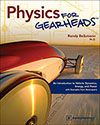|
Now Available! |
Physics for Gearheads
Price: $119.95
|

The Boston Globe - July 12, 2015
Laws of physics for gearheads
Summer reading generally runs toward a page-turning best-seller for the pool or deck or beach. You know, formula writing.
However, we found a different kind of "formula writing" in an automotive book that came our way in May at the automotive technology conference jointly sponsored by MIT and the New England Motor Press Association.
It's Physics for Gearheads by Randy Beikmann, who earned his Ph.D. in mechanical engineering at the University of Michigan and has been a technical specialist in automotive noise and vibration since 1983 at General Motors Milford Proving Ground.
Beikmann says, "As a gearhead, you have a secret advantage when it comes to understanding physics: You see it at work every time you solve a problem with your car or watch a motorsports event. The experience you already have tuning cars or motorcycles is your virtual physics lab. 'Physics for Gearheads' will show you that if you can learn about cars, you can learn about physics."
It's 608 pages with 347 photos, diagrams, and illustrations. Plus hundreds of formulas. Retail cost is $79.95 at Bentleypublishers.com.
Maurice Iglesias of Bentley Publishers said that day at the conference, "I'm eager to get your impressions on this book."
My first conclusion is that the operative word here is "gearhead," and the first corollary to that is that I don't fit that description.
Those of us who consider it an achievement to replace a radiator hose, serpentine belt, or headlight don't qualify as gearheads-at least not on this level.
This would be a terrific textbook for a college-level course in automotive engineering, learning how to compute how kinetic energy of a vehicle in motion is converted to heat in the braking process, how the heat in a fuel is turned into power, or how to predict the force on a suspension pushrod.
For me, it's enough to know that it happens, not to be able to compute it.
Beikmann says, "In automotive design, physics is the right tool for splitting the problem up and for solving each part."
He also says, "Don't get the wrong idea, though. This isn't trivial stuff. It took many great thinkers years of effort to develop the laws [of physics] and then gradually combine them into this neat package we call physics."
In an understatement, he says, "Don't worry when you have to read something twice."
Local drag racers will love his formulas for gearing a race car: Is it more important to have a short gear for a quicker start or a longer gear for a higher top speed at the finish? Where is the sweet spot in between?
In each of his chapters, Beikmann starts with an overview, then he advances to specific examples, illustrations, and formulas.
One of his sections deals with the basics of fuel economy and compares internal combustion engines with electric motors.
"Highway driving is mainly cruising at a constant speed, so most of your energy goes to overcoming rolling resistance and aerodynamic drag," he writes. Thus heavier cars with similar aerodynamic profiles don't pay a big fuel economy price on the highway. However, accelerating to those speeds is another story.
As for internal combustion vs. electric, Biekmann writes, "For an IC engine at constant speed, we assume the engine converts 28 percent of the fuel's heat into work, of which 90 percent makes it through the driveline to move the vehicle, for a propulsion efficiency of 25 percent."
So how about the electric vehicle?
"We start at the electric power plant where about 32.5 percent of the fuel energy becomes electric power (67.5 percent goes out the smokestack and cooling tower). Of that 32.5 percent, some is lost in transmission lines and in charging and discharging the vehicle battery and in the motor. The overall propulsion efficiency is 25 percent, about the same as for the internal combustion engine."
With an old lead-acid battery, you'd need about 22 pounds of battery per mile of driving range; with today's Li-Ion, that's down to 2.75 pounds of battery per mile. In contrast, you need about two-tenths of a pound of gasoline or diesel fuel per mile.
In a footnote, Beikmann says, "I was surprised at how close they [gas engines and electric motors] were [in efficiency]. In fact, I felt a little sheepish that this wasn't obvious to me right off. I've gotten over it since."
That's also an example of the humor that Beikmann weaves into his writing, a nice counterpoint to the heavy doses of physical laws and formulas.
He foresees a future using both forms of propulsion with EVs attractive for urban areas for their lack of local pollution, no time wasted idling, and the use of regenerative braking to reclaim energy.
But he also calls the choice between the two a false one because we now have a variety of hybrids to balance the equation, though, as he says, "getting that across to a customer to the extent they can make a logical decision, is no easy task."

Review from and courtesy of The Boston Globe - July 12, 2015
![[B] Bentley Publishers](http://assets1.bentleypublishers.com/images/bentley-logos/bp-banner-234x60-bookblue.jpg)
